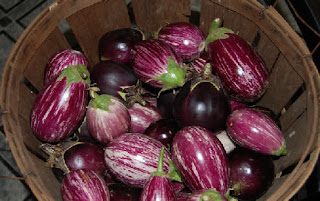It was time to think outside the
squash to prepare the zucchini in the share last week. Everyone
loves a crunchy potato chip—how about zucchini chips? Some recipes call for breading and baking them, like the one below; I’ve done that before to make baked
zucchini sticks, which are delicious with cocktail sauce, but I was looking for
the real thing, thin and crispy.
So I got out my mandoline and sliced a
zucchini very, very thin—paper thin, almost. You could definitely see through the
slices. I set them between sheets of paper towels to get some of the liquid
out, then I heated oil in an electric fry pot and threw in a few slices at
a time. It took awhile for them to brown and crisp up, but when I drained them
on fresh paper towels, then added a little salt and Cajun seasoning, they were
just what I was aiming for—crispy zucchini chips, as you can see in the photo.
It’s probably no surprise that this is a way
to take something good for you and make it not-so-good for you, and it’s not
environmentally correct, either—the process used a lot of paper towels. But I think I would have to say it was a
successful experiment in making locally grown junk food!
Next time I may try this more healthy (and
less paper-towel dependent) recipe to make zucchini chips. I think I’d have to
cut them a bit thicker, too; the paper thin slices just won’t hold up to
batter. If you still have zucchini to prepare, you can decide if you want to go
healthy or junk food all the way with your own zucchini chips.
Low Carb Zucchini
Oven Chips
1/4 cup ground almonds
1/4 cup grated fresh Parmesan cheese
1/4 t seasoned salt
1/4 t garlic powder
1/8 t black pepper
2 T fat-free milk
2 1/2 cups (1/4 inch-thick) slices zucchini (about 2 small)
Cooking spray
Preheat oven to 425 degrees. Combine the first five ingredients in a medium bowl, stirring with a whisk. Place milk in a shallow bowl. Dip zucchini slices in milk, then dredge in dry mixture. Place coated slices on an ovenproof wire rack coated with cooking spray; place rack on a baking sheet. Bake for 30 minutes or until browned and crisp. Serve immediately.
1/4 cup ground almonds
1/4 cup grated fresh Parmesan cheese
1/4 t seasoned salt
1/4 t garlic powder
1/8 t black pepper
2 T fat-free milk
2 1/2 cups (1/4 inch-thick) slices zucchini (about 2 small)
Cooking spray
Preheat oven to 425 degrees. Combine the first five ingredients in a medium bowl, stirring with a whisk. Place milk in a shallow bowl. Dip zucchini slices in milk, then dredge in dry mixture. Place coated slices on an ovenproof wire rack coated with cooking spray; place rack on a baking sheet. Bake for 30 minutes or until browned and crisp. Serve immediately.












